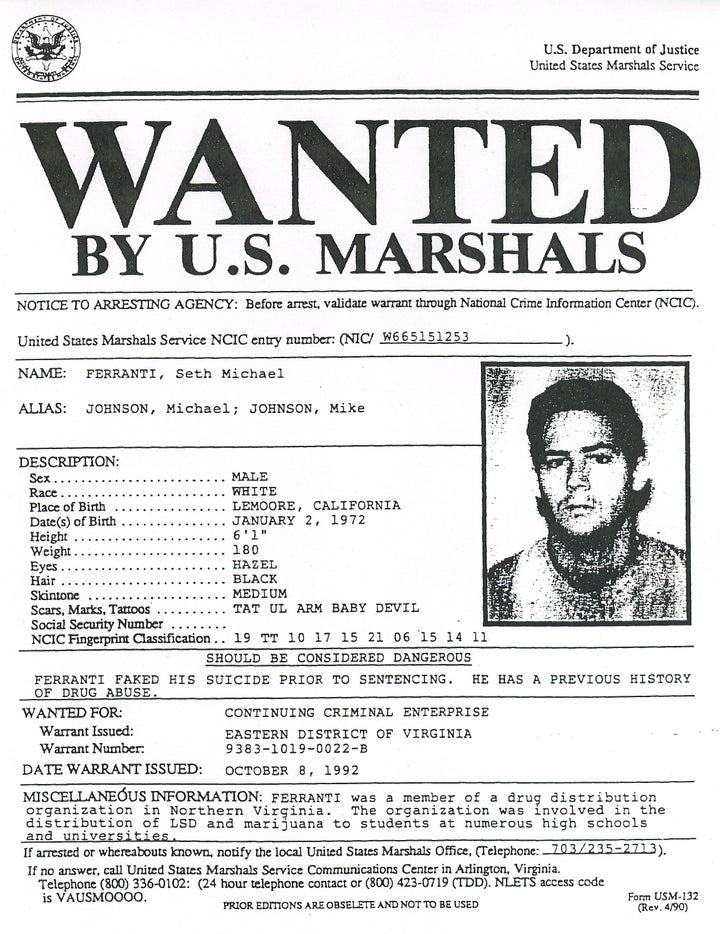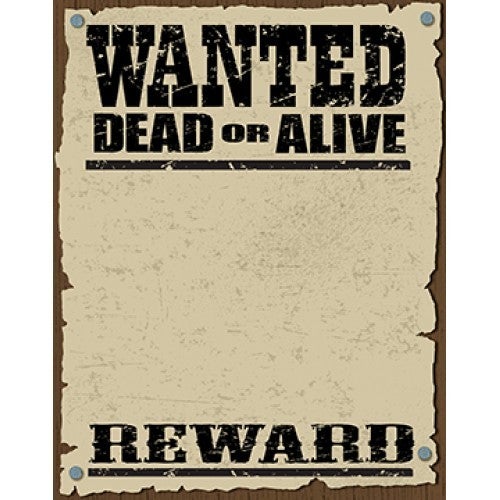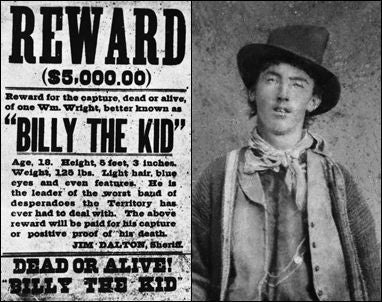
When I went on the run in 1991, to avoid facing a 25 year prison sentence for selling LSD and marijuana at East Coast colleges, I was named to the US Marshal’s Top 15 Most Wanted list. A bazaar turn of events considering I was a first-time, nonviolent offender who’d never carried a gun or even beat anyone up. But as a fugitive from justice my wanted poster was circulated to law enforcement agencies around the country and posted up in every US Post Office. Unintentionally, I’d joined a very exclusive group of criminals and outlaws that stretches back to the Wild, Wild West. From the Pinkerton Agency to frontier sheriffs and governors to the FBI and US Marshal’s, the history of the most wanted poster parallels the tales of infamous criminals.
As photography and printing methods evolved, law enforcement officials starting posting “Wanted Dead or Alive” posters advertising bounties and soliciting public cooperation, help and even participation to apprehend alleged criminals, outlaws and desperado’s. In addition to the bounty, a photo and brief description of the crime was given. On my most wanted poster it reads “Should Be Considered Dangerous,” not armed and dangerous, just dangerous. I was wanted for running a “Continual Criminal Enterprise,” an ongoing drug conspiracy in Northern Virginia, in which I allegedly managed five or more people and made significant cash profits. My alias’ were given and the poster mentioned how I faked my suicide prior to sentencing and that I had a previous history of drug abuse.

Luckily I wasn’t wanted “Dead or Alive.” In the early days of most wanted poster that was the norm. With gunslingers in the Old West wanted for train robbery, horse theft, safe blowing, seduction, bank robbery, white slavery and murder, often times killing the fugitive was the only option. The disclaimer gave bounty hunters and vigilantes a license to do what was necessary and not shoulder the blame If the criminal was inadvertently shot during the attempted capture and delivery to authorities for the bounty.
“In a time where mass media didn't exist, issuing a wanted poster served as a means to distribute information.” Martin J. Kidston, author of Wanted! Wanted Poster of the Old West, tells me. “They were primarily used on a local level for neighboring cities and towns, given that an alleged criminal couldn't just hop in a car and drive hundreds of miles in a matter of hours. In some cases, the posters were more widely distributed, though in Montana, more times than not, they were circulated in nearby counties. There was no radio, television or internet – no social media or 24-hour news channel. Issuing a poster was one's best bet in getting the public's attention and alerting nearby law enforcement.”

A lot of the notorious bandits who’ve had the unfortunate fate to grace a most wanted poster have became immortalized as outlaw-heroes in pop culture. Names like Jesse James, Billy the Kid, John Dillinger and Bonnie and Clyde come to mind. An eclectic club of dastardly outlaws that’s captured the public’s imagination for generations. In the 1840s, Missouri Governor Thomas T. Crittenden offered a $5,000-per-man-bounty for the James gang and in the 1930s the FBI offered a bounty of $10,000 for John Dillinger. Compare that to today when the FBI paid the tipster who turned Irish Godfather James “Whitey” Bulgar in $2.1 million.
Wanted posters have been utilized by media sources for propaganda effects also. In the September 4, 1939 edition of the Daily Mirror, a British newspaper, Adolf Hitler was cast as a “reckless criminal” who was “wanted dead or alive.” The same tactics were used more recently in the case of Osama Bin Laden. In 2001 The Times put the Al Queda leader on a most wanted poster with the reward for capture listed at $25 million. TIME magazine observed in 1939 that the FBI “usually considers it undesirable to dignify Public Enemies by listing them,” but by the 1950s the FBI’s Ten Most Wanted Fugitive list was created. Today that list includes not only fugitives but terrorists, criminals and even missing or kidnapped people.
“In 1949, a reporter for the predecessor of the United Press International wanted to do a story on some of our most dangerous fugitives and asked if we could give him some information about them.” John Fox, FBI Historian, said. “We provided him some of the details about 10 such fugitives along with their alleged crimes, background and identification information and asked the public for help in locating them. The interest and leads generated from his story led us to formalize a public outreach program to identify and disseminate information about similar criminals the next year. This became the 10 Most Wanted Fugitives program, which has led to the identification and capture of hundreds of notorious fugitives since then.”

Almost ninety-five percent of the fugitives profiled on the FBI’s Top Ten list have been captured since it was first introduced. The basis for being put on the list considers if the fugitive is a danger to society of if adding them to the list would increase the likelihood of capture. In 1919, the predecessor to the modern most wanted list was issued as an Identification Order (IO) for military deserter William Bishop. Since then over 6,000 IO’s have been issued for criminals and fugitives including “Pretty Boy” Floyd (IO No. 1194), “Machine Gun” Kelly (No. 1203), John Dillinger (No. 1217), “Baby Face” Nelson (No. 1223) and Bonnie and Clyde (No. 1227). Eight-by-eight inch flyers which displayed the fugitive’s photo, criminal record, background information and fingerprints became common place in post offices and police stations around the country.
And to keep up with the times the FBI started posting wanted posters on billboards in 2007. With access to over 5200 billboards nationwide the agency casts a very wide net. Getting as many eyes on the information as quickly as possible. From sheets of paper to posters to billboards to digital notices on the Internet, the most wanted poster has evolved accordingly. In the 1950s the list tended to be comprised of bank robbers, burglars and car thieves, but in the 1960s revolutionaries involved in kidnappings and destroying government property became prominent. By the 1970s it was all organized crime figures and terrorists and today the list is dominated by drug traffickers, sexual predators and international terrorists.
“The FBI has been using wanted posters since the 1930s to inform the public about fugitives who are sought to face criminal charges in court.” Fox said. “We have put criminals from bank robbers like John Dillinger and Alvin Karpis to serial killers like Ted Bundy to terrorists like Osama Bin Laden [on the list]. The subjects of our wanted posters reflect the priorities of the Bureau and the threats that it faces. From newspapers, radio and Post Office walls we moved to working with television programs like the very successful America’s Most Wanted and Unsolved Mysteries. As new communications technology develop, you can be sure we will be adapting them to help us catch the criminals who threaten our fellow citizens.”
Other law enforcement agencies have also got into the act.
“In July 1982, the Enforcement Operations Division came up with the concept of the Fifteen Most Wanted Program. It was partially to highlight some of our most difficult cases, and also to create a way to effectively communicate these cases with the public.” David S. Turk, a historian for the US Marshals Service (USMS), tells me. “Inspector Robert Leschorn actually created the draft of the very first Fifteen Most Wanted in February 1983. He literally used pen and glued or taped thumbnail pictures on letterhead to show the draft appearance. The agency created publication USM-132 for display purposes in district offices, post offices, and other venues. Each form was printed on heavy stock, as they had to stand in Fifteen Most Wanted boards at each district office with interchangeable slots. As to the actual wanted poster appearance, this was a tie to the historical wanted posters of the Old West. This was because it attracted attention and stood out from other types of similar programs.”
I was a on the US Marshal’s Top 15 Most Wanted List and I’ve always wondered why I was put on that list. Was it because I took off and didn’t show up for my sentencing or was it down to the fact that they figured that was the quickest and easiest way to catch me. I also wondered what the differences were between the two lists.
“The short answer is that the U.S. Marshals Service's Fifteen Most Wanted and the FBI's Ten Most Wanted were patterned the same way, but addressed different subjects.” Turk says. “The FBI had an investigative mission that was wide-ranging, and their focus was on the national and international issues of the time. The USMS were apprehending fugitives that either escaped or failed to appear in court. Since that time, our personnel took on more complex types of cases. Despite the names of both programs, there are inherent differences.”
Like the FBI’s, the US Marshal’s list is commonly posted in public buildings like post offices. Mob figures like Colombo boss Alphonso “Allie Boy” Persico and former Nazi leaders like Josef Mengele have been captured by the US Marshal’s. They caught me to and extradited me back to Virginia in 1993 to face the music and a 304 month federal sentence for selling drugs. I was even asked to sign my most wanted poster for the Marshal’s who paraded law enforcement personnel by my cell to show off their big catch. It seemed that my most wanted poster gave me that extra bit of notoriety, just like the Old West gunslingers, in the chronicles of outlaw lore.
“I don't believe these men would be legends in modern times. They would be seen for what they were- criminals. Perhaps they are revered today only due to time and place. They represent a time in American history that is often distorted by pop culture misunderstood. The West was a difficulty place, and while it has occupied a part of our cultural curiosity, the criminals of the day were just that- criminals.” Kidston tells me. “The only thing that has changed is the media platform. Bank robbers and murderers were just as despised in the 1800s and they are today. Movies might make them out to be some sort of hero, but in real life, they are dangerous people. America's Most Wanted reaches an enormous audience hoping for that one tip that might catch an elusive criminal. The same was true in the 1800s. Back then, law enforcement was also hoping for a tip that might bring a criminal to justice, and a wanted poster was their only option. If they had television back then, I'm certain they would have used it.”
